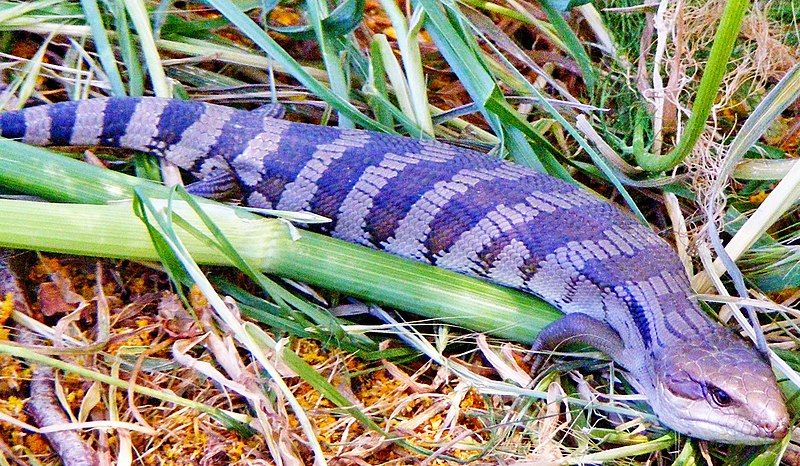 Please see Part I of this article for notes on other aspects of skink care (temperature, light, etc.) and taxonomy.
Please see Part I of this article for notes on other aspects of skink care (temperature, light, etc.) and taxonomy.
Diet
Blue Tongue Skinks have very accommodating appetites, which makes it easy to provide them with a varied, balanced diet – not often the case with lizards in general!
The bulk of their diet – 60-70% – should be comprised of a mixed salad of greens and vegetables, to which has been added a small amount (i.e. 10% by volume) of fruit. Kale, bok choy, dandelion, mustard and collard greens, beets, various beans, squash, carrots, yams, apples, figs, papaya and other seasonally available produce should be offered, with variety being a key point.
Animal-based protein can be provided by canned Tegu-Monitor Diet, canned insects or, if you prefer, live crickets, roaches, super mealworms, butter worms and wild-caught invertebrates. Many folks use canned cat food or monkey chow as a protein source, but I prefer products formulated for lizards.
Tricking Fussy Feeders
Like many lizards, Blue Tongues can become overly fond of certain foods, and refuse to take others. A friend in England let me in on a secret which she claims is often used by European hobbyists – vanilla custard! The skinks are said to consume anything that is coated with this favored treat (strawberry jam works for Box Turtles, so why not!).
Vitamin-Mineral Supplements
Young skinks grow rapidly and need lots of Calcium and other nutrients. For the first year or so of their lives, coat all food with supplements, alternating between Reptocal and Reptivite w/D.
Adults fed a varied diet will require supplements one or two times weekly.
Breeding
Captive reproduction is a real possibility for those with a compatible pair – with emphasis on “compatible”. The chief impediment to reproduction is finding a male and female that will tolerate one another’s company long enough to allow for mating. Injuries inflicted by the powerful jaws during fights can be severe, so you’ll need to monitor introductions carefully.
 It is best to house skinks separately until you are ready to pair them up, and to place the larger, more aggressive animal into the smaller individual’s terrarium, to remove the “home court” advantage.
It is best to house skinks separately until you are ready to pair them up, and to place the larger, more aggressive animal into the smaller individual’s terrarium, to remove the “home court” advantage.
Potential breeders should be pre-conditioned by spending 4 weeks or so at a temperature of 60-68F, during which time they do not need to be fed (please write in for details). Although UVB light is not essential for Blue Tongue Skinks, UVA is likely very important in regulating their behavior, and may help to stimulate reproduction. A UVA-emitting lamp is a wise investment for all reptile breeders, especially those who work with diurnal (day active) species such as Blue Tongue Skinks.
Females bear 6-20 live young; in the past I have separated them from the female within a week or so, but others report success in raising the brood with their mother.
Further Reading
Range and other in formation for all species in the genus Tiliqua is posted here.
Folks who live in Blue Tongue Skink territory get to see all sorts of interesting things, as this video, “Skink vs. Magpie” target=”_blank”illustrates.
Juvenile BlueTongued Lizard image referenced from wikipedia and originally posted by Peripitus
BlueTongued Lizard image referenced from wikipedia and originally posted by D. Gordon E. Robertson
 That Reptile Blog – Reptile, Amphibian and Exotic Pet Care and Information
That Reptile Blog – Reptile, Amphibian and Exotic Pet Care and Information



Hello Frank,
Been enjoying your excellent selection of articles and this one stands out in particular because I have been somewhat considering some kind of lizard…these guys seem like they’d be a pretty good choice for something large, interesting in behavior, yet no overly large(such as a tegu), or with high heat/UVB requirements(many iguanids). Do you know many other species that fit this bill? I saw someone advertising Gallotia stehlini on KS…they are out of my price range unfortunately, but seem like mini tegus in many respects.
~Joseph
Hello Joseph,
Thanks very much for the kind words.
A few temperate zone species come to mind – Broad-Headed Skinks, Alligator Lizards; colonies of smaller skinks, i.e. Five-Lined, are also very interesting. Sheltopusiks (please see article) are a favorite of mine, but need more room than the others. I lean towards UVB with all of the above, but there has been success with little or none. I also enjoy Tokay Geckos (need warmer temps than above), night-viewing lights may help in observing them.
Good luck and please keep me posted.
Best regards, Frank Indiviglio.
Hello Mr. Indiviglio, I will be getting a Merauke locality Blue Tongue this weekend and I wanted to know if you could give me any additional information about them, specifically their diet and its composition. I’ve also emailed the San Diego and Houston zoos about them but I couldn’t find any contact information for the Bronx zoo reptile department, would you know of it?. Thanks!
Cheers, Alex
Hi Alex,
The diet described in the article is the one we used at the Bronx Zoo for many years; most of my contacts there have moved on since I’ve retired, and as far as I know they do not usually take calls from the public re care etc. these days. best, Frank